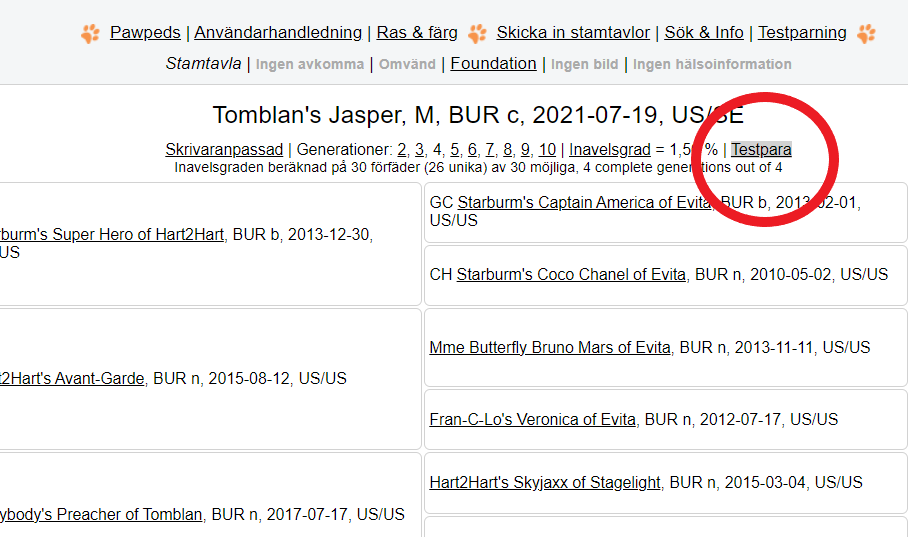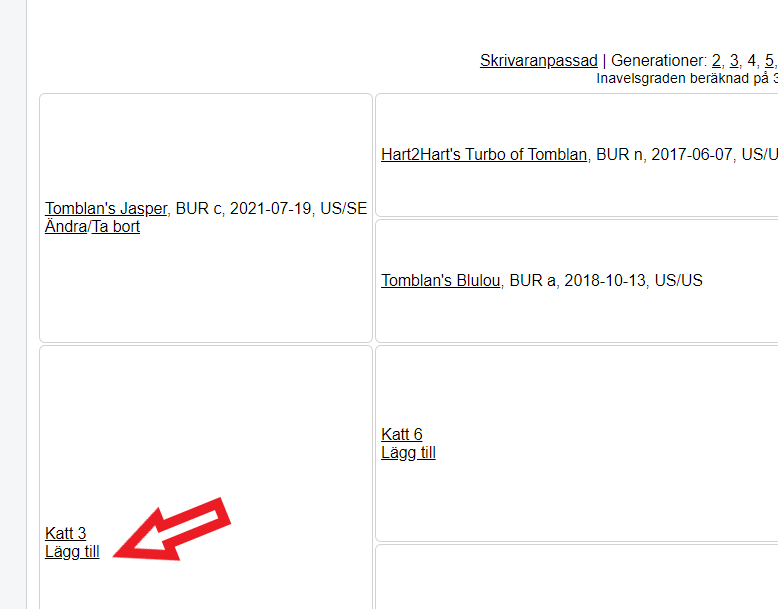Test Mating Pawpeds
https://www.pawpeds.com/db/?p=bur
If you click on Test mating in the page header, you will get an empty pedigree, in which you can fill in animals from the database, to create a test mating. Click on ‘add cat’ (or ‘add dog’ or what ever species it is) in the position where you want to enter an animal. Then you search for and select the animal of your choice. Then click on ‘add cat’ in another position, search and select an animal, etc. Continue until the pedigree is filled up. Then you can look at inbreeding coefficients and pedigree analyses as usual.
If you then click on ‘Test mating by using this cat as sire’ (or dog/horse/ferret etc.), the animal – with the entire pedigree – that you have in front of you will be moved so that it will be the sire in a testmating pedigree with empty positions on the dam’s side. If you click on ‘Use this cat (dog/horse/ferret…) as dam’ instead, the animal in front of you will be moved to the position of the dam in a pedigree with empty space on the sire’s side.
You can also click on the words Cat 2, Cat 3, etc. (or Dog 1, Horse 1, etc.), or on the name of an animal, in order to look at the pedigree of the selected animal, and make calculations for that pedigree.
By clicking on the link ‘Change’ you can replace an animal already in the test mating pedigree. If you want to remove an animal from the test mating pedigree, you click on ‘Remove’ in the pedigree.
The link Test mate in the line just above an animal’s pedigree is a shortcut to make a testmating with the animal you have in front of you as the sire or dam. You can then add the other parent, or the grandparents, as usual, by clicking on ‘add cat’ (or ‘add dog’, ‘add horse’ etc.) in the position of your choice.


Inbreeding Coefficient
The inbreeding coefficient is a measure of the proportion of loci that are homozygous because of the relationship between the parents. In other words, it is the percentage of probability that a particular locus is homozygous due to the relationship between the parents. So 100 % would mean that the animal is homozygous in every locus. That is, for every gene the animal inherited from the mother, an identical gene was also inherited from the father. A high inbreeding coefficient occurs when the father and the mother are closely related. An inbreeding coefficient of 0 % would mean that no locus is homozygous because of any relationship between the parents. If the inbreeding coefficient is 0 %, it means that the parents of the animal are not related.
Some comparison matings:
- When a cat is mated with a sister/brother: 25 %
- When a cat is mated with a parent: 25 %
- When a cat is mated with a halfsister/halfbrother: 12.5 %
- When a cat is mated with a grandparent: 12.5 %
- When a cat is mated with a cousin: 6,25 %
If we knew the background of an animal for thousands of years, then all the animals in that huge pedigree would be a little bit related and the inbreeding coefficient of an animal would never be 0 %. If such an animal were compared to an animal whose background is only known for a few generations, it would appear as if this animal were much less inbred. But this, of course, is not necessarily true. When we are comparing pedigrees, we must always consider for how many generations we are calculating the inbreeding coefficient.
The program will give you the inbreeding coefficient for the number of generations that the pedigree shows. If you would like to have the inbreeding coefficient calculated as far back as there is info in the database, you can click on the word ‘inbreeding’. This coefficient will then be calculated. Note though that this inbreeding coefficient is no more complete than the pedigree is in the database! Be sure to check if there are any ancestors missing before interpreting the meaning of any inbreeding coefficient, regardless of the number of generations it is calculated from!
How high inbreeding coefficient should we allow?
According to population geneticists the average coefficient, of all the matings we do in a breed, should increase by less than 0,25-0,5 percentage point per generation. If the increase is higher, the population will be at risk of health problems due to inbreeding. It might take many generations before the problems become visible, but when they arise they will be difficult to remove from the breed.
Looking at individual matings, no single mating should be closer than approximately the mating of first cousins. This is in order to avoid direct inbreeding damage in the resulting litter.
Reverse Pedigree
There is also an option to make a reverse pedigree. This means that you can see from any given animal its offspring, grand-offspring, great-grand-offspring, etc. When you are on the page with the pedigree of a specific animal, in the row above the name you will see ‘Reverse’. When you click on it you get a list of all the descendants of this animal, up to a maximum of 10 generations and/or 1.000 animals. In that list you will see behind some names [rev], this means that for this animal too a reverse pedigree is available.
